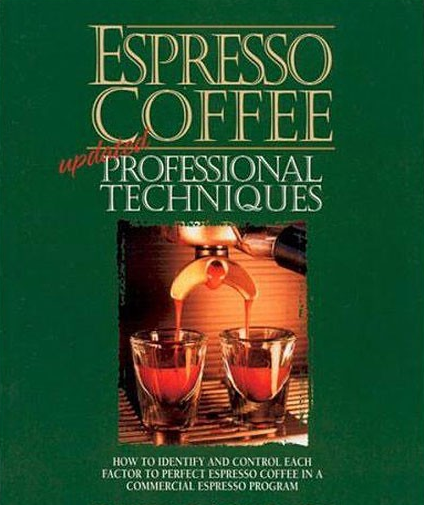Coffee books recommend David Schomer's "ESPRESSO COFFEE"

(Ⅰ)
The first part of the basic concepts
Espresso principle
Establish a knowledge architecture
Just a bunch of facts, just a bunch of facts. Theory is the skeleton of fact. The experience of teaching others to cook espresso taught me one thing: if I told newcomers about the basic theory of espresso at the beginning, it would be easier for them to cook a good espresso after the course. Because in order to cook a good espresso, you have to face complicated practical problems. With a proper theoretical basis, their ability to understand problems can be enhanced.
Why is it so hard to cook espresso?
The problems with making a great espresso are mostly due to two factors: "uneven flow of water" and "the aroma of coffee is very volatile".
The problem of current
Modern espresso machines can produce water pressure of 120 to 130 pounds, while coffee cakes are less than half an inch thick. The big problem with espresso comes from espresso's feature: using pressurized hot water to pass through a thin coffee cake.
Water has one characteristic:
He will always find the shortcut with the least resistance in the coffee powder, instead of trying to extract the soluble coffee oil. So a large part of this book is about how to make coffee powder evenly resistant to high-pressure water.
As long as the coffee filter cake has a little uneven density or the surface collapses, the high-pressure water will rush up and break through your "cover door". In the coffee filter cake, the low density part will be over-extracted after the delicious ingredients flow out. On the other hand, the parts with higher density are not extracted enough.
When this espresso flows out, the water flows in a spiral shape. The surface tension is relatively high and it is tightly attached to the outlet. In addition to the delicious reddish-brown liquid, there are white lines and small cups of coffee.
To make matters worse, it happens when the beans are ground too thick or the resistance of the filter cake is uneven. As soon as the high-pressure water is leaking, the light brown liquid is pouring down.
It looks like a toilet in color and taste.
To cook a perfect espresso like this
Grind the correct amount of coffee powder, carefully flatten it and disperse it, and then rotate and grind it out after being evenly compacted with a filler. After being done, there should be some gaps between the surface of the coffee filter cake and the shunt net of the machine outlet. Turn on the pump switch and the water will flow down and wet the coffee powder for about a second before the pump is actually started. This is called "prepreg", which helps seal the surface of the filter cake (Italian engineers are well aware of the benefits of "prepreg"), and the delicious ingredients in the powder do not stick so tightly when they come into contact with hot water. It's easier to extract when high-pressure water comes over.
Because the cooking temperature is as high as 200 degrees Fahrenheit and the pressure is as high as 120 pounds. If the resistance of the filter cake is uneven, it will rush out of the hole or pore diameter, resulting in uneven extraction. The part of insufficient extraction will cause the yellowish-brown liquid of water in the outlet head, and the part of over-extraction will dissolve other substances and cause white stripes.
In fact, what is said above is just an idealized overview. There are many factors that seriously affect the ability of coffee powder to withstand water pressure, such as: filling, dosage, freshness of beans, thickness of grinding, blade form of bean grinder, and air humidity. Only by controlling these many factors and understanding their relationship with each other can the matter be resolved.
When all is done, for the next 25 seconds, you can see high-pressure water squeeze through the coffee powder and inject a perfect cup of espresso.
Selected from: ESPRESSO COFFEE: Professional Techniques 1996
Important Notice :
前街咖啡 FrontStreet Coffee has moved to new addredd:
FrontStreet Coffee Address: 315,Donghua East Road,GuangZhou
Tel:020 38364473
- Prev

A complete collection of coffee tasting terms that coffee lovers need to know
- Next

Chapter 2 of David Schomer's "ESPRESSO COFFEE"
(Ⅱ) aromatic ingredients tend to dissipate the rich aroma of fresh coffee that has inspired poets for hundreds of years. In order to capture these aromas in coffee cups, all kinds of beautiful shapes and strange coffee machines have come out one after another, thus achieving this arduous super task. It is necessary to make the brewed coffee as fragrant as the freshly ground coffee.
Related
- Detailed explanation of Jadeite planting Land in Panamanian Jadeite Manor introduction to the grading system of Jadeite competitive bidding, Red bid, Green bid and Rose Summer
- Story of Coffee planting in Brenka region of Costa Rica Stonehenge Manor anaerobic heavy honey treatment of flavor mouth
- What's on the barrel of Blue Mountain Coffee beans?
- Can American coffee also pull flowers? How to use hot American style to pull out a good-looking pattern?
- Can you make a cold extract with coffee beans? What is the right proportion for cold-extracted coffee formula?
- Indonesian PWN Gold Mandrine Coffee Origin Features Flavor How to Chong? Mandolin coffee is American.
- A brief introduction to the flavor characteristics of Brazilian yellow bourbon coffee beans
- What is the effect of different water quality on the flavor of cold-extracted coffee? What kind of water is best for brewing coffee?
- Why do you think of Rose Summer whenever you mention Panamanian coffee?
- Introduction to the characteristics of authentic blue mountain coffee bean producing areas? What is the CIB Coffee Authority in Jamaica?

